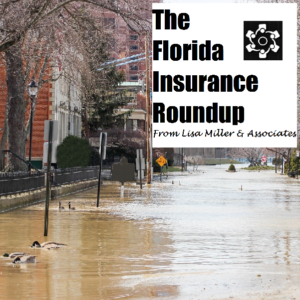Florida’s challenge

Northside Jacksonville flooding from Tropical Storm Cristobal, June 7, 2020. Courtesy, WJXT-TV
I had the pleasure of sitting down recently to talk with two flood experts on the growing problem of urban flooding and what mitigation approaches are being tried – and working – here in Florida and in Texas. It’s an especially timely topic for hurricane season. We recorded the conversation for our latest episode of the Florida Insurance Roundup podcast.
Dr. Sam Brody of Texas A&M University called urban flooding a “hidden danger” among all flood risks in the country. He should know, having studied Hurricane Harvey in Houston and co-authoring The Growing Threat of Urban Flooding: A National Challenge 2018. The report revealed neighborhoods that were miles away from known flood risk zones but were surrounded by man-made barriers, such as roads, railroad tracks, and sound walls, referred to as “built environment barriers,” that end of creating flood hazards.
The study looked primarily at rainfall, but urban flooding can occur with tidal events, too, including high-tide or “sunny day” flooding, as seen in some South Florida communities. Our other expert, Dr. Alec Bogdanoff, is Principal Scientist and Co-Founder of Brizaga, a Fort Lauderdale, Florida based firm that assists businesses and communities in becoming more resilient to flooding. He said some storm water systems, which are meant for collecting and sending rainwater out to sea are instead becoming conduits for saltwater to back up into communities during this period of sea level rise.
“The challenge comes if you end up with a high-tide sunny day flooding example and instead of it being a sunny day, it’s a rainy day. You now have to wait for the tides to go down before that rainwater is going to go out,” Bogdanoff said. “We’re trying to have people understand that it’s not if you’re in or out (of a flood zone), it’s how far you are from that boundary and there are gradients of risk extending outward from the hundred-year flood plain that people need to be aware of.”
 The podcast also discussed solutions. Brody said his team, with support from FEMA, has developed a new method to predict and map hazards and risk. Instead of hydrology and hydraulics models, they are using statistics and machine learning techniques to improve flood prediction. “We may not replace the FEMA floodplain maps but we can augment them and complement them to help resident be more prepared and mitigate impacts,” he said.
The podcast also discussed solutions. Brody said his team, with support from FEMA, has developed a new method to predict and map hazards and risk. Instead of hydrology and hydraulics models, they are using statistics and machine learning techniques to improve flood prediction. “We may not replace the FEMA floodplain maps but we can augment them and complement them to help resident be more prepared and mitigate impacts,” he said.
Bogdanoff said Broward County has developed a series of “incremental but fairly significant” changes to improve resiliency. They include a one-hundred year flood map that guides future development, a Fort Lauderdale seawall ordinance to provide better flood protection, another ordinance requiring flood disclosure, new infrastructure improvements, and efforts to encourage resilient building design. “Ultimately what you want is insurance to be the last risk transfer. We want to do as much as we can to protect people so that they don’t have to use insurance,” he said.
As you’ve heard me say before, “flood water doesn’t understand a line on a map,” and property owners need to actively consider purchasing flood insurance. Both gentlemen shared additional programs and solutions to mitigating flooding and we’d urge our readers to listen to the podcast or read the show notes here.
A big thank you to those readers who commented on the story in the last newsletter edition and its reprint in the Claims Journal: Nuisance Flooding Becoming Worse. Appreciate your interest and feedback!
LMA Newsletter of 8-3-20

